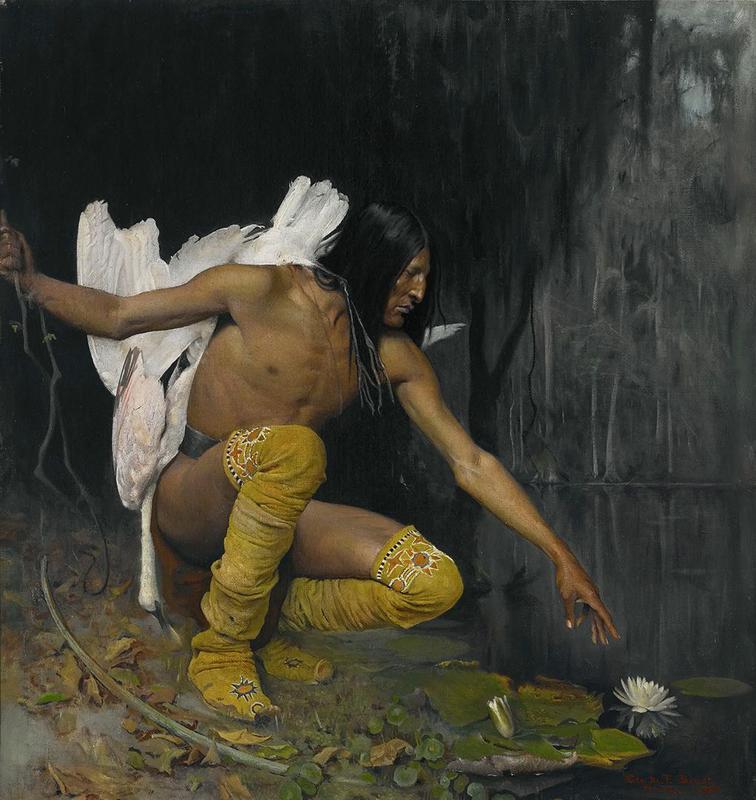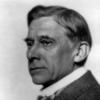More about The Indian and the Lily

Sr. Editor
In The Indian and the Lily, George de Forest Brush poetically remarks upon the tragic and violent hardships Native American indigenous people have suffered because of the actions of the United States government.
Though, in actuality, de Forest Brush was also concerned with the rapid industrialization happening in the country, and tied this together with the Native Americans’ plight. For the artist, the figure of the Indian was a symbol for the traditions being lost in the rush towards modernization. This is not to say that his portrayals are shallow or somehow unsympathetic; as the grief and longing of the man depicted in The Indian and the Lily make clear, de Forest Brush also wanted to sincerely express Native Americans’ humanity, at a time when they were systematically being dehumanized in the name of “war” and “progress.”
In the late 1880s, the Apache Indians became the last Western tribe to surrender to the American Army and their efforts to conquer Native land and push indigenous people onto reservations. President Grover Cleveland, believing that there was risk of the Apache warriors reorganizing to fight if left in the West, ordered the capture and imprisonment of all Apache people, who were then transferred to Fort Marion in Saint Augustine, Florida. This is where George de Forest Brush found his inspiration for The Indian and the Lily.
As you might expect, the conditions in this prison were horrid. It was overpopulated, rife with disease and malnourishment, and families were routinely ripped apart when children were taken from their parents and sent to Christian boarding schools to be re-educated in order to “assimilate” with white culture. Though de Forest Brush visited this prison in person, and would have certainly been witness to the suffering there, he does not depict any concrete details of this experience in this painting. Instead, the man is shown seemingly outside of time and place, in an “idealized world of peace and pristine nature.” This follows the romanticized view of Indian culture that was popularized in the late 1800s, and continues to permeate the American imagination to this day.
While we can applaud de Forest Brush for dignified depictions of Native American people, rather than as caricatures, he still in some ways treats the dramatized figures in his paintings as stand-ins for his own ideas, rather than as individuals. They sometimes act merely as symbols for his fantasy of “untouched civilization,” similar to the treatment of Eastern cultures in Orientalist art and literature. De Forest Brush once said, “In choosing Indians as a subject for art, I do not paint from the historian’s or the antiquary’s point of view.…Therefore, I hesitate to attempt to add any interest to my pictures by supplying historical facts. If I were required to resort to this in order to bring out the poetry, I would drop the subject at once.” The pure white lily can be seen as one of these poetic references to virginal land and traditions yet unsullied by European interference.
The bird upon the man’s back, which looks like a pair of angel’s wings, is a Roseate Spoonbill, a species hunted almost to extinction by European Americans who valued the pink-tinged feathers for decorating ladies’ hats. We can understand its inclusion as a message from de Forest Brush - who did sincerely befriend and learn from many different Indian cultures throughout his life - warning of the threats facing Native American people, and as a call for preservation and peace. Later in life, de Forest Brush was reportedly so distraught at his government’s treatment of Native people that he stopped painting them as subjects altogether. His daughter, Thea Cabot, said: “He was heartbroken about how the Indians...had been cheated of everything...These Indians were his friends and after seeing what had happened to them, he couldn't paint them anymore.”
Sources
- Morgan, Joan B. “The Indian Paintings of George de Forest Brush.” American Art Journal 15, no. 2 (1983): 60–73. https://doi.org/10.2307/1594337.
- “Apache Incarceration.” National Parks Service. U.S. Department of the Interior, 2018. https://www.nps.gov/casa/learn/historyculture/apache-incarceration.htm.
- “George De Forest Brush: The Indian Paintings.” National Gallery of Art. Accessed September 14, 2021. https://www.nga.gov/features/slideshows/george-de-forest-brush.html.
- Morgan, Joan B. “The Indian Paintings of George de Forest Brush.” American Art Journal 15, no. 2 (1983): 60–73. https://doi.org/10.2307/1594337.
- “The Indian and the Lily.” Crystal Bridges Museum of American Art. Accessed September 14, 2021. https://collection.crystalbridges.org/objects/35/the-indian-and-the-lily.











